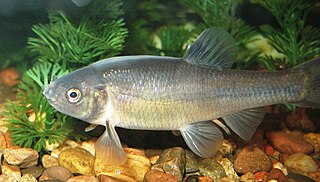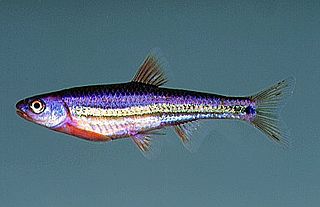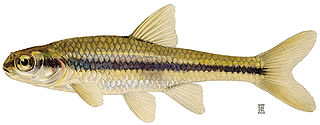
The emerald shiner is one of hundreds of small, silvery, slender fish species known as shiners. The identifying characteristic of the emerald shiner is the silvery emerald color on its sides. It can grow to 3.5 inches in length and is found across North America from Canada to the Gulf of Mexico, commonly in large, deep lakes and rivers, though sometimes in smaller bodies of water as well. It feeds on small organisms such as zooplankton and insects, congregating in large groups near the surface of the water. It is a quite common fish and is often used as a bait fish.

Pimephales, commonly known as the bluntnose minnows, is a genus of cyprinid fish found in North America. All of the four species are small fish, with P. notatus being the largest at 11 cm. These minnows can be found all over North America and are commonly used as fish bait.
Enteric redmouth disease, or simply redmouth disease is a bacterial infection of freshwater and marine fish caused by the pathogen Yersinia ruckeri. It is primarily found in rainbow trout and other cultured salmonids. The disease is characterized by subcutaneous hemorrhaging of the mouth, fins, and eyes. It is most commonly seen in fish farms with poor water quality. Redmouth disease was first discovered in Idaho rainbow trout in the 1950s. The disease does not infect humans.

Notropis is a genus of freshwater fish in the family Cyprinidae. They are known commonly as eastern shiners. They are native to North America, and are the continent's second largest genus.

The bridle shiner is a member of the minnow family (Cyprinidae). This species has been identified as being of Special Concern by the Committee on the Status of Endangered Wildlife in Canada (COSEWIC).

The spottail shiner or spottail minnow is a small- to medium-sized freshwater minnow. It can be found as far north as Canada and as far south as the Chattahoochee River in Georgia. These shiners live in lakes, rivers, and creeks. They occupy the rocky or sandy shorelines and bottoms of the water. One of the defining features of a spottail shiner is the black spot found at the base of the caudal fin. These shiners generally spawn from late June through July.
The carmine shiner is a freshwater fish species. In Manitoba, it was once known as the rosyface shiner. Based mostly on zoogeographic data, it is currently classified as a distinct species within the rosyface shiner species complex. The carmine shiner is a member of the Minnow family, Cyprinidae. It has the following characteristics and distinguishing features:

Leuciscinae is a subfamily of the freshwater fish family Cyprinidae, which contains the true minnows.

The scarlet shiner is a freshwater fish native to the eastern United States.

The bluntnose minnow is a species of temperate freshwater fish belonging to the genus Pimephales of the cyprinid family. Its natural geographic range extends from the Great Lakes south along the Mississippi River basin to Louisiana, and east across the Midwestern United States to New York State. The bluntnose is very ubiquitous, and may be the most common freshwater fish in the Eastern U.S.

The North Yamaska river is a tributary of the Yamaska river. It flows over 47.8 kilometres (29.7 mi) on the south shore of the Saint Lawrence river in Quebec, Canada and passes through five municipalities, some of them sourcing their fresh water from it.

Pogonichthyinae is a subfamily of the freshwater fish family Leuciscidae, which contains the true minnows. Members of this family are known as American minnows or the North American (NA) clade of minnows. As the name suggests, all members of this family are found in North America (although they are not the only minnows native to North America, as Plagopterinae, Laviniinae, and Leuciscinae are also found there).












